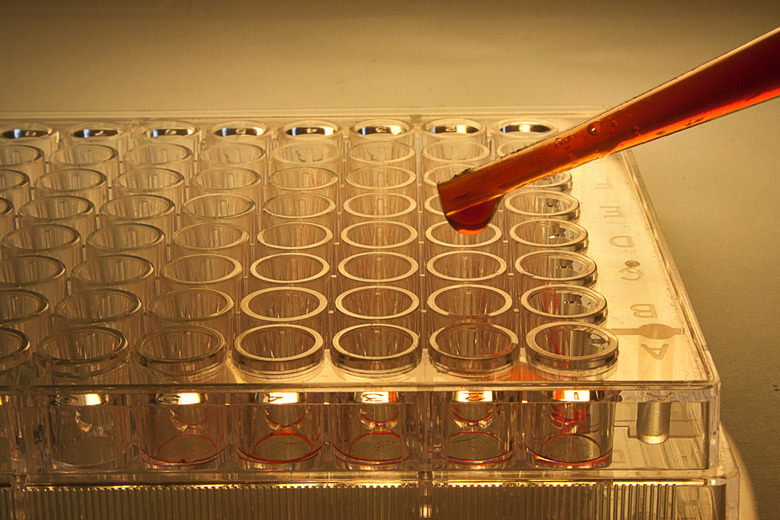How To Calculate The Percentages Of Adenine In A DNA Strand
When most people hear the term "DNA," they automatically picture the classic double helix. Imagining the components that make up that great spiral of genetic material often feels a bit more complicated. Fortunately, understanding how base pairs function and even calculating percentages for each base in a DNA sample is actually straightforward.
TL;DR (Too Long; Didn't Read)
In any DNA sample, there are four bases that pair in only one way: adenine and thymine, guanine and cytosine. They total 100 percent of the sample. Chargaff's rule states that the concentration for each base in a base pair is always equal to its mate, so the concentration of adenine equals the concentration of thymine, for example. Using this information and simple math, you can find the percentage of adenine in a sample if you know the percentage of any other base.
DNA Base Pairs
DNA Base Pairs
The DNA double helix contains two strands of genetic material twisted together, so it fits inside the nucleus of the cell. The structure of that spiral results from the way the four bases pair up and bind to each other. These four bases are adenine, guanine, thymine and cytosine.
In terms of chemical structure, adenine and guanine are both purines while thymine and cytosine are pyrimidines. This chemical difference ensures that the stable hydrogen bonds between the bases always pair up the same way: adenine with thymine and guanine with cytosine.
Erwin Chargaff’s Observation
Erwin Chargaff's Observation
Scientists have not always known the function of DNA. In fact, the 1944 proposal that DNA might be the cell's genetic material inspired speculation and even controversy. Nevertheless, some scientists began to study DNA in earnest, including Erwin Chargaff. In 1950, Chargaff noticed that, when separated, the purines (adenine and guanine) always existed in a 1:1 ratio with the pyrimidines (thymine and cytosine). This finding became a scientific fixture: Chargaff's rule.
Applying Chargaff’s Rule
Applying Chargaff's Rule
Chargaff's rule means that in any sample, the concentration of adenine will always equal the concentration of its pair thymine, and the concentrations of guanine and cytosine will be equal, too. If you need to calculate the percentage of adenine in a DNA sample, you can use Chargaff's rule to solve the problem. For example, if you know the DNA sample is 20 percent thymine, you automatically know it is 20 percent adenine, as well, since they pair together.
You can also calculate the percentage of adenine when given the percentage of guanine or cytosine. Since you know there are only four bases in DNA, all four bases together must equal 100 percent of the sample. If given the information that the sample is 20 percent guanine, you can surmise it is also 20 percent cytosine since guanine and cytosine pair with each other. Together, that is 40 percent of the total sample. You can subtract that 40 percent from 100 percent and determine 60 percent of the sample must be adenine and thymine together. Since those two bases always exist in equal concentrations, you know the DNA sample is 30 percent adenine.
Concepts associated with the biochemistry of DNA sometimes seem very complicated. Thanks to Chargaff, calculating the percentages of bases present in a DNA sample becomes nothing more than a simple math problem.
Cite This Article
MLA
Mayer, Melissa. "How To Calculate The Percentages Of Adenine In A DNA Strand" sciencing.com, https://www.sciencing.com/calculate-percentages-adenine-dna-strand-8562135/. 9 May 2018.
APA
Mayer, Melissa. (2018, May 9). How To Calculate The Percentages Of Adenine In A DNA Strand. sciencing.com. Retrieved from https://www.sciencing.com/calculate-percentages-adenine-dna-strand-8562135/
Chicago
Mayer, Melissa. How To Calculate The Percentages Of Adenine In A DNA Strand last modified August 30, 2022. https://www.sciencing.com/calculate-percentages-adenine-dna-strand-8562135/
